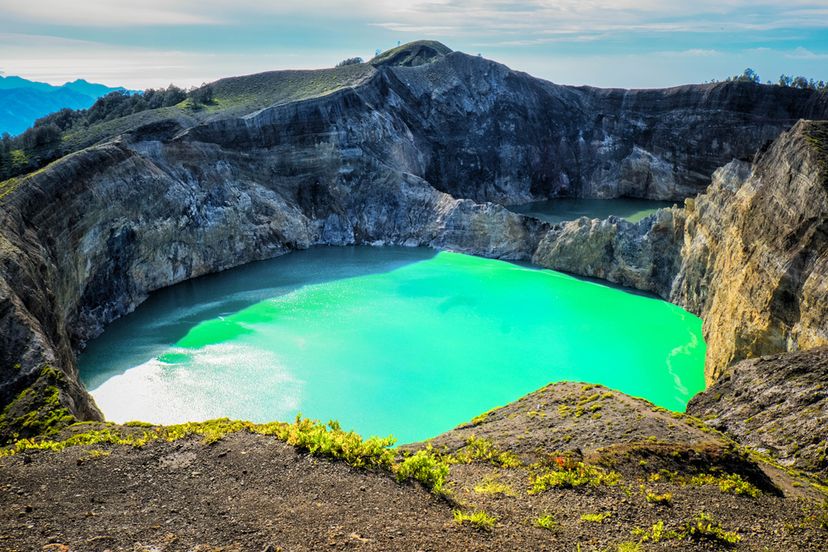
Are you tired of visiting the same locations as millions of other tourists each year? Have you visited places like the Grand Canyon in the USA, Machu Picchu in Peru, and the Coliseum in Italy, but now feel yourself longing for something less ‘typical’? Our Earth is filled with an excess of far-fetched places, some we have all heard of, and some we haven’t. While locations like the Grand Canyon, Machu Picchu, and the Coliseum are all spectacular sites to visit, they are overrun by tourists each year, littering the beauty of their location. Maybe it’s time to start discovering destinations that are not on most people’s radar, but equally as stunning- if not more. Traveling somewhere beautiful and undiscovered makes for a special trip. There’s just something charming about going to a place that isn’t as well known. Here are 14 Breathtaking Places You Probably Didn’t Know Existed to add to your travel bucket list.
Advertisement
14. Quiraing
To visit the Isle of Skye in Scotland without experiencing the Quiraing seems entirely unthinkable. Part of the Trotternish Ridge, which was formed by a great series of landslips, the massive landslip in the Quiraing has created tall cliffs, hidden plateaus and peaks of rock. The Quiraing is the only part of the slip that is still moving and requires repairs each year. Parts of the distinctive landscape have earned particular names, such as the Needle, which is a jagged 120-foot high landmark pinnacle, a remnant of land slipping. Northwest of it is the Table, a flat grassy area from the summit plateau, with views of the marvelous Torridon Hills and the mountains of Wester Ross. Southwest is the Prison, a pyramidal rocky peak that can look like a medieval keep when viewed from a proper angle.
If you are fit enough, walk the narrow path and journey up and down the vertical slopes. Classed as medium in length, and hard in difficulty, it covers a distance of 4.2 miles, with the average time to complete the walk being roughly 2 hours with no stops. You are guaranteed wonder and amazement with some of the most incredible landscapes and beautiful sunsets found in Scotland- so don’t forget to bring your camera!

Advertisement
13. Hvítserkur
Hvítserkur is a rock that rises 50 feet from the sea, found on the eastern shore of the Vatnsnes Peninsula, in the northwest of Iceland. Hvítserkur, which means “white shirt” in Icelandic, comes from the color of the sea-bird excrement deposited on the rock from the several species of birds that reside on it. This unusual rock formation was once the plug of a volcano, but over the years the craters surrounding the rock plug gave way to the pounding Atlantic Ocean, leaving only the bizarre outcropping of Hvítserkur behind. To protect the rock’s foundations, the base of the rock has been reinforced with concrete, helping it stay in its place. At low tides it is possible to walk out beyond the protruded rock.
In 1990, the geological oddity was even commemorated on an Icelandic stamp. Since the rock has two holes at its base, some say it looks like a thirsty dragon drinking from the Atlantic Ocean. Icelandic legend says that the rock used to be a troll that forgot to retreat itself from the light and as a consequence was turned to stone during sunrise.

Advertisement
12. Hamilton’s Pool Preserve
Located about 23 miles west of Austin, Texas, this unique natural pool has been a popular summer destination for Austin visitors and its residents since the 1960’s. Hamilton’s Pool Preserve is a natural pool that was created when the dome of an underground river collapsed due to thousands of years of massive water erosion. Cultural remains date this site back over 8,000 years.
The Preserve consists of 232 acres of protected natural habitat containing a beautiful jade green pool into which a 50-foot waterfall drops into the canyon adding to a pool of water that never entirely dries up. The pool is surrounded by large chunks of limestone that rest by the water’s edge and large stalactites that grow from the ceiling above. Hamilton’s Pool Preserve contains lush plant communities and a plethora of wildlife species. Flora ranges from semi-arid species in the uplands to riparian species in the canyon. In the uplands of the preserve you can find juniper and oak savannah with a variety of native grasses and wildflowers. In the canyon, you can see several rare plant species including canyon mock-orange, red bay, and chatter box orchid. Fauna include a variety of birds such as the endangered golden-cheeked warbler and cliff swallows.

Advertisement
11. Namaqualand
Namaqualand is an arid region of Namibia and South Africa, extending over 600 miles along the west coast. Namaqualand becomes a popular destination in early spring, for both local and international tourists; when for a short period of time, this typically arid area becomes covered with a kaleidoscope of color during the flowering season (early August to late September). This area receives very little rain throughout the year, however after the winter rains of May through July, the normally barren landscape becomes a canvas of a variety of different wild flowers with vibrant colors.
The wide variety of wild flowers is largely due to the varied topography in this region. For example, many fertile valleys contrast with the high mountains, the semi-desert plains of the north contrast with the unique sandveld region near the coast with its wetter areas. Certain flora is found nowhere else in the world except in this area. Some years are better than others, all depending on the winter and spring seasons. Countless paintings, poems, novels, and prose have been dedicated to this annual spectacle of color, and rightfully so.
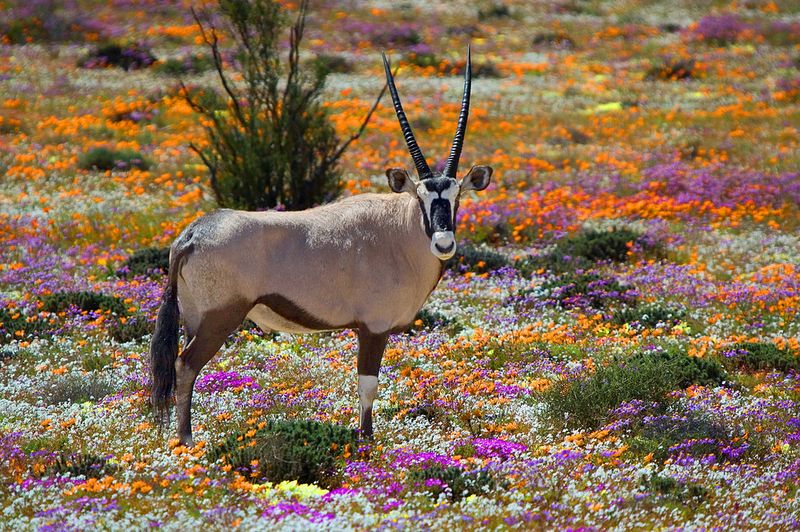
Advertisement
10. Dean’s Blue Hole
While most other known blue holes only reach maximum depths of 360 feet, Dean’s Blue Hole, found in a bay west of Clarence Town on Long Island in the Bahamas, plunges a whopping 663 feet down below, making it the deepest known salt water blue hole. It is still unknown exactly how Dean’s Blue Hole was formed since it’s much deeper than most blue holes, but one hypothesis is that a much deeper cave slowed and moved upward as its ceiling eroded away.
The coral caves and sand banks on the side of the entrance are home to all kinds of tropical reef life, like shrimps, snappers, and groupers. Friendly sea turtles can sometimes be found in the hole taking a break from the ocean currents, and schools of tarpon fish hang in the hole’s shadows. In April 2010, professional and courageous diver William Trubridge broke a free-diving world record in the blue hole by reaching a depth of 302 feet without the use of fins. He decided to take it a step further in December of 2010, when he swam to a depth of 331 feet on a single breath while using only his hands and feet for propulsion!
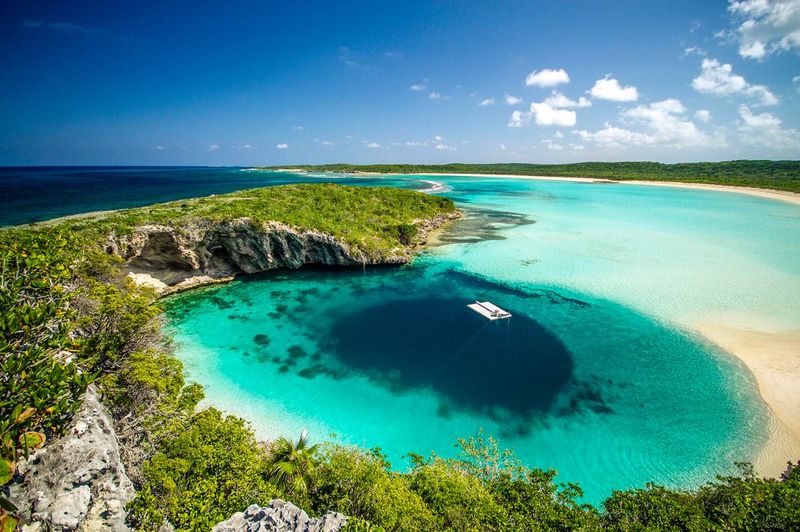
Advertisement
9. The Flatirons
The Flatirons are rock formations near Boulder, Colorado, and is the perfect place for hikers and climbers. Although the Flatirons are made up of several small formations, there are five large, numbered Flatirons, from north to south, along the east slope of the Green Mountain, that are the most popular. Climbing options in the Flatirons can vary between obscure boulders and chunks scattered through the woods to technical summits and chillingly exposed towers. Climbing history dates back over a hundred years, and generations of the world’s best climbers have developed their skills on these Flatirons.
Accessible via trailheads in Chautauqua Park, there are dozens of named formations and established routes numbered in the hundreds to the thousands. A significant number of the routes finish on high summits and should not be missed if you enjoy climbing long and reasonable routes with worthwhile finishes. Certain climbs, the First and Third Flatirons for example, can be very crowded on weekends, but it’s easy to find solitude in the multitude of other less visited cliffs. Noteworthy summits in the Flatirons, aside from the numbered Flatirons themselves, include: the Devil’s Thumb, the Maiden, the Matron, Seal Rock and the Amphitheater towers.
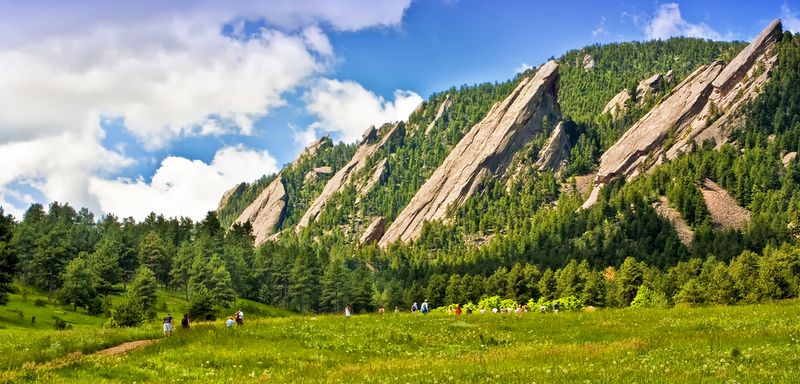
Advertisement
8. Benagil
The bluer-than-blue waters of this small Portuguese town are home to a mind-blowing sea grotto. This grotto, or algar in Portuguese, is found on the Algarve coast of Portugal –the country’s most southern coast. The grotto is located 500 feet to the east of the small beach and little fishing village of Benagil. The sea cave has two magnificent entrances, a huge collapsed roof, a secluded beach of sand and a circular inner grotto.
Access to this beautiful place is only by water. The first, easiest and most comfortable, is by commercial boat. Tours leave from several beaches nearby and some include this and other caves around the area as well. If you do take the tour however, you are not allowed off the boat. Another great option is renting a kayak. Many of the same companies that provide the boat tours also rent the kayak equipment. This option is recommended for those that want to go more inside the grotto and take some breathtaking pictures.
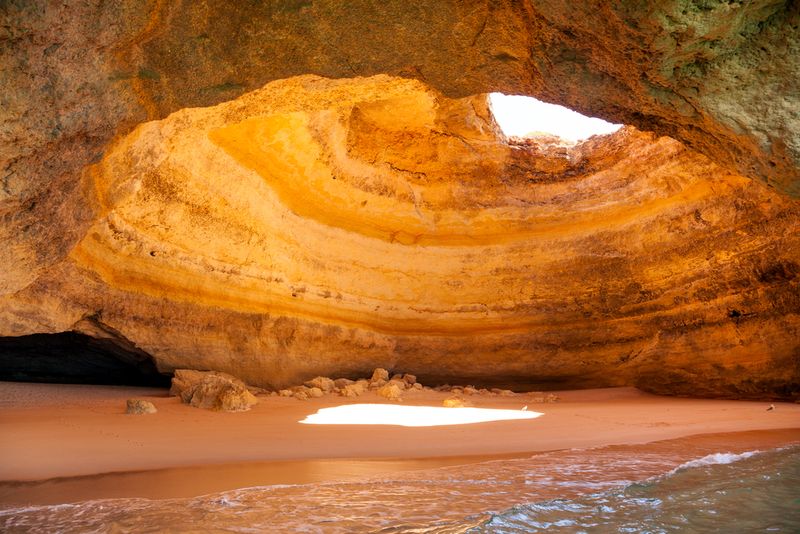
Advertisement
7. Whitehaven Beach
A postcard perfect beach, Whitehaven Beach is a 4.3 mile stretch along Whitsunday Island, Australia and is the largest of the 74 islands in the Whitsundays. The turquoise, blue and green water, and the fact that the sand is 98% pure white silica give this place a brilliant, near luminescent color. The crystal clear aqua waters and pristine silica sand make it the most photographed beach in Australia. At the northern end of Whitehaven Beach is Hill Inlet, a stunning cove where the tide shifts the sand and water to create a beautiful fusion of colors. As the tide shifts, the white silica sand and shades of turquoise blend flawlessly to create a breathtaking view of swirling Whitsunday colors. It definitely defines nature at its best and provides the greatest sense of relaxation and escape for tourists from all over the world.
Whitehaven Beach is just a thirty-minute trip on a high-speed catamaran, and Hamilton Island offers several Whitehaven Beach day trips and Whitehaven Beach tours. Visitors can also choose to take a scenic helicopter tour and seaplane flights over Hill Inlet to give visitors an amazing aerial view of the magical water and sand dance below them.
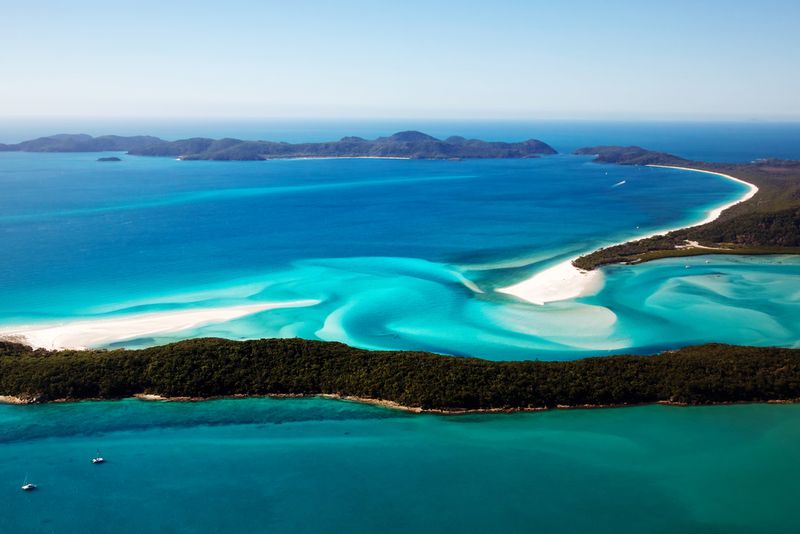
Advertisement
6. Vatnajokull Ice Caves
Quiet a mesmerizing wonder of nature; the Vatnajokull ice caves are located inside an Icelandic glacier. Located on the south-east of the island, Vatnajokull itself is the largest and most voluminous Icelandic ice cap, and without a doubt one of the largest in area in Europe, so it’s no wonder visitors want to enter this massive glacier and explore its ice caves with their blue color and intriguing light. Created by the forces of the Vatnajvkull ice cap, the ice caves emerged as a result of its glacier meeting the Icelandic coastline. The cave’s ice dates back centuries, and its weight has pressed out all remnant air, so the resultant formation’s texture and colors are both brilliant and out of this world. The jewel-like interior of the ice caves makes adventure seekers feel as though they are in some sort of fairy tale world.
During the winter months is the best time to visit this attractive phenomenon, in terms of accessibility and also in terms of safety. However, it is always a risk to enter an ice cave and that risk increases late in the winter. Extreme caution is advised when visiting these caves and visitors should be accompanied by a tour guide and proper safety equipment. Conditions can also be different between caves and further safety equipment might be required.
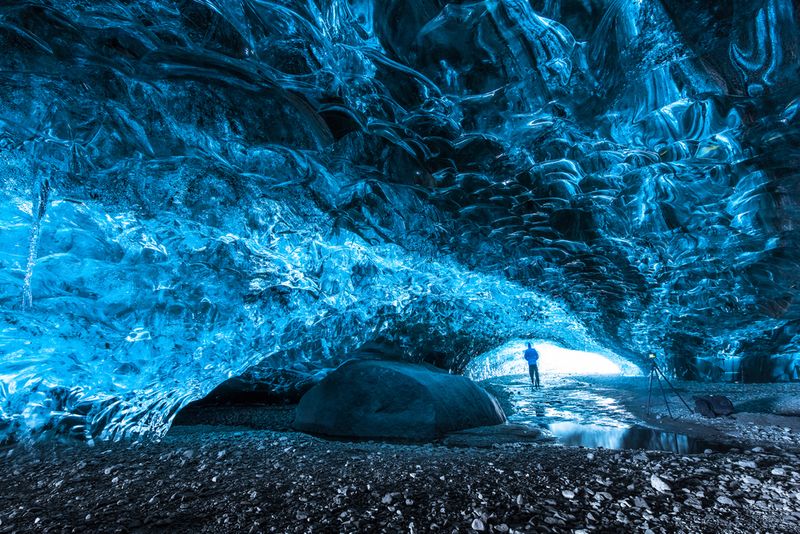
Advertisement
5. Lake Natron
Dry, desolate and hauntingly beautiful; wild and remote Lake Natron lies in the northeast of Tanzania in between the Ngorongoro Highlands and Serengeti plains. Situated at the base of Africa’s only active volcano Oldonyo Lengai, meaning Mountain of God, Lake Natron is one of the most alkaline lakes in the world. The alkaline water in Lake Natron can reach a pH as high as 10.5 and is so alkaline in fact, it can burn the skin and eyes of animals that aren’t adapted to it. The water’s alkalinity comes from the sodium carbonate and other minerals that flow into the lake from the surrounding hills, hot springs, and small rivers. Since it is a shallow lake in a hot climate, its water temperature can reach as high as 106 degrees Fahrenheit.
Many rumors surround Tanzania’s Lake Natron, claiming the lake turns animals to stone. While the temperature and pH do indeed make it a dangerous place for a lot of creatures, the myths are only partly true. In fact, the lake is home to millions of tiny crustaceans, and during breeding season, the lake attracts more than 2 million lesser flamingos that use the shallow lake as their primary breeding ground in Africa, making it one of the most important flamingo breeding grounds on Earth.
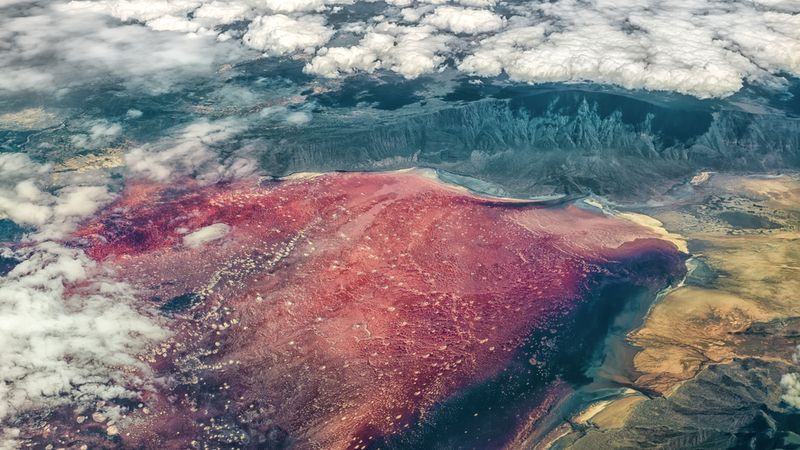
Advertisement
4. Kelimutu
Mount Kelimutu, located on the island of Flores, is an Indonesian volcano and home to three summit crater lakes. Kelimutu itself means Boiling Lake and often visitors can see wreathes of steam rise from the surface of the lakes. The summit can be accessed via trek by those adventurous enough to hike to the crest of Kelimutu. Although they are all located on the same volcanic peak, each lake is distinctly a different color and fluctuates between shades as well. Although no extensive scientific evidence has been done, it’s assumed that the color variations are due to underwater fumaroles. These are openings in the planet’s surface which let out gas and steam that creates an upwelling and constantly change its appearance. As a result, the visitor is never quite sure what color the lakes will be when they reach the top.
The three crater lakes all have different names and for centuries the locals have believed that the lakes are the spiritual resting place of their ancestors. It is said the lakes change color according to the mood of the spirits. The Lake of Old People is where it is said the spirits of the old who have led honorable lives go to rest. The Lake of Old People is typically blue. The Lake of Young Men and Maidens is characteristically green. The third, the Enchanted Lake can often be seen as blood red or even olive green. Supposedly, this is the lake where the evil people go, regardless of age or sex.
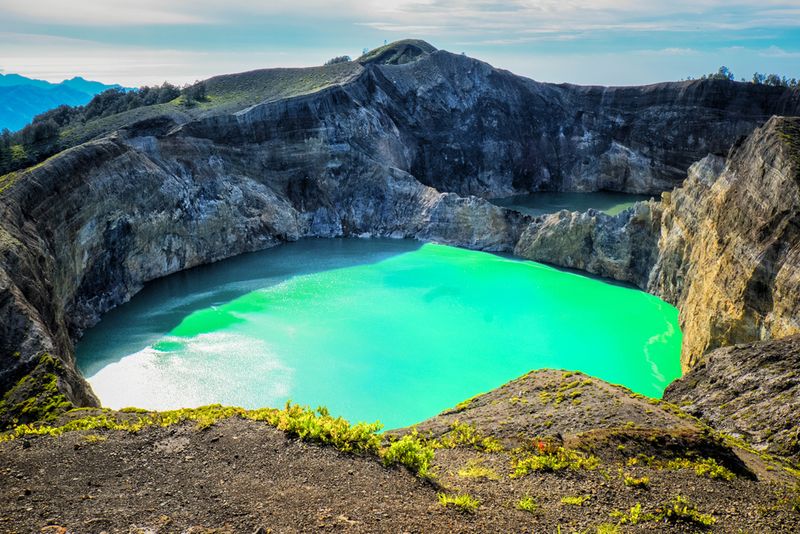
Advertisement
3. Lake Resia
Bordering Austria and Switzerland, Lake Resia holds Italy’s most famous drowned town. The 3.7 mile long Lake Resia, with its majestic background of the Vallelunga Valley, looks something like out of a postcard, but the history behind it is far less pleasant. More than 60 years ago, after the end of World War II, the city of Curon was flooded by a power company’s plan to join two natural lakes to create a giant dam. Now, the only visible remnant of the sunken town is the Romanesque bell tower of a submerged 14th-century church. Below the waters of Lake Resia, the remains of over 163 buildings are now home to fish and other creatures, rather than people.
Nowadays, visitors and tourists can hike or bike along the stunning mountain path surrounding the lake (which is also known as Reschensee or Lago di Resia). During the winter months, the waters above this sunken town freeze, allowing visitors to walk on water and to access the only visible relic of Curon. Prior to demolition and creation of the lake, the bells of the church were removed, but rumor has it that during the winter months the church bells still sound. Spooky!
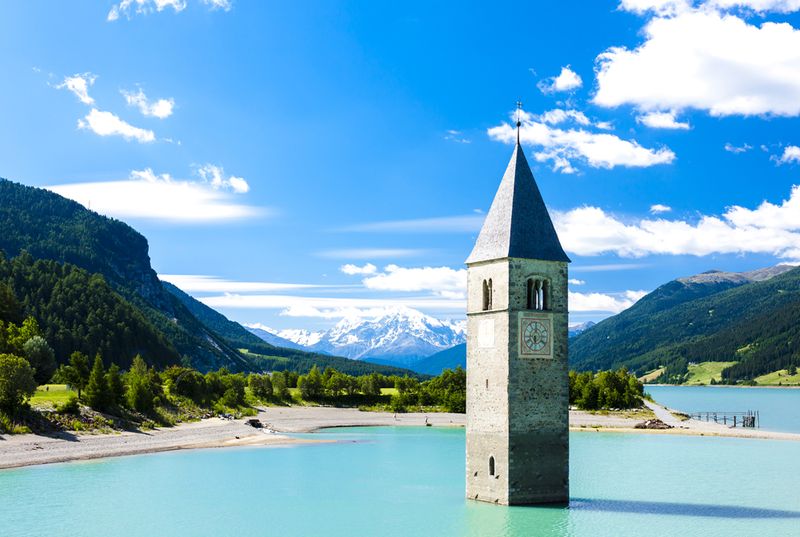
Advertisement
2. Gullfoss
Gullfoss, translated to “Golden Falls”, is one the most visited tourist attractions in Iceland, and by far Europe’s most powerful waterfall. Part of The Golden Circle tourist route in Southern Iceland, the three primary stops of the route are Thingvellir National Park, Gullfoss Waterfall, and the geysers Geysir and Strokkur. Gullfoss is situated in the upper part of the River Hvita (White River); the water cascades down two distinct drops in succession at right angles of each other, one 36 feet high, and the other 72 feet high, into a 1.5 mile long canyon below. The rock of the river bed was formed during an interglacial period. On a sunny day, the mist clouds surrounding the thrashing falls are filled with tons of rainbows, providing a marvelous display of color and motion.
Gullfoss almost disappeared due to the desire for hydroelectricity by various foreign enterprises at the beginning of the 20th century. The daughter of the farmer who owned the land opposed this and even threatened to throw herself into the falls. She fought bravely against the use of the falls for hydroelectricity for decades, and thanks to her extreme efforts, The Ministry of Culture and Education finally signed an agreement creating a nature reserve around Gullfoss in 1979. There is even a memorial near the falls commemorating the farmer’s daughter.
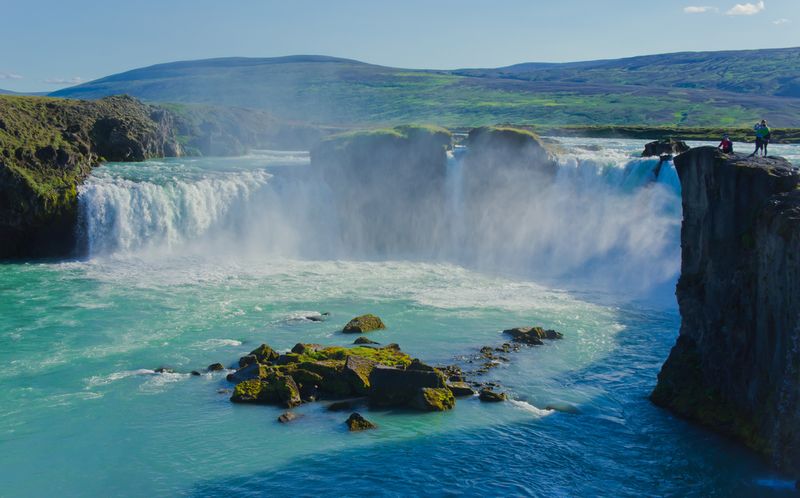
Advertisement
1. Melissani Cave
Located on the Greek island of Kefalonia in the Ionian Sea, in Greek mythology, the site is also known as the Cave of the Nymphs. The cave has a lake inside of it, and on the outside, the cave is surrounded by lush green vegetation. The cave itself is B-shaped with dual chambers, which are separated by an island in the center. The roof of one of the chambers is caved in, allowing sunlight to enter the sky-blue colored lake, creating a magical illusion that the whole cave of Melissani is lit with blue light and that boats are floating through the air. The cave is 11.5 feet long, 118 feet high, and 131 feet wide. A balcony was built on top of the cave for tourists to get a spectacular view of the inside from the top.
Legend has is that the nymph Melissani committed suicide in the lake because Pan, god of the wild, shepherds, and flocks, and companion of the nymphs, would not reciprocate Melissani’s love. Dolphins are also associated with this myth, having been used by the nymph to carry messages to her beloved Pan. After her death the dolphins turned into stone in the cave, and you can quite clearly see the shapes of dolphins in the stalactites within the cave.
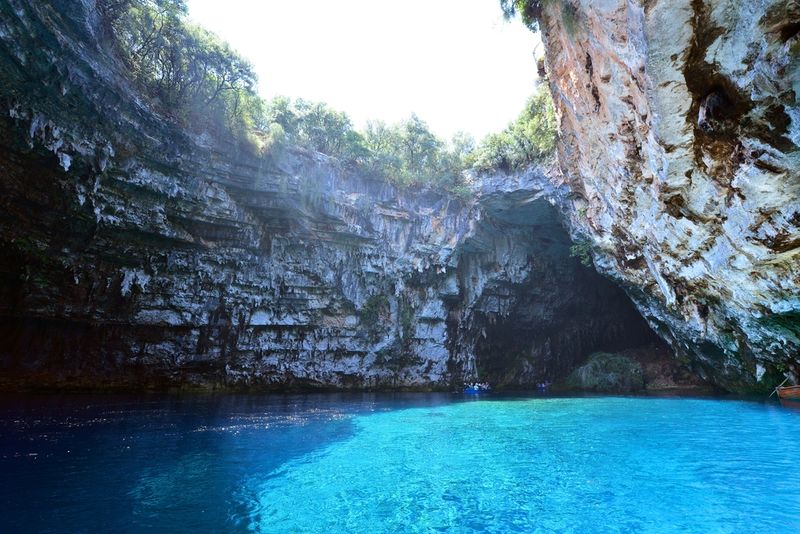
Advertisement